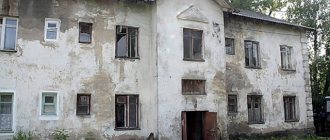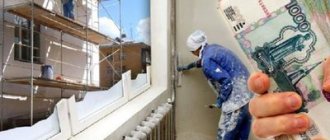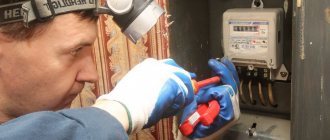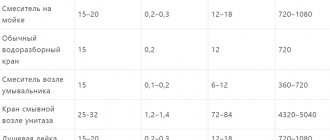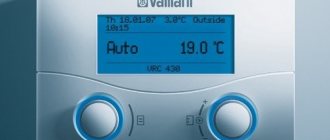What is included in the maintenance of common property in an apartment building 2020
common areas of the house - this is a large list of work that is carried out throughout the year. It is drawn up based on the rules for maintaining housing and the needs of the house, as indicated by the residents. The management company will have to fulfill this “to-do list”. In this article we will talk about what work must be performed and what additional requirements can be required from representatives of the management company.
What is included in the maintenance of housing in an apartment building and what is it?
Since these services are paid for by the owner of the house or the organization that owns it. The tariff is calculated separately for each group of services - the cost of major repairs and work to maintain a residential building in proper condition is determined.
In this case, the management organization’s proposals regarding the list, volume and quality of services and work are taken into account. Particular attention is paid to the composition, design features, degree of physical wear and tear and technical condition of the common property of a particular house.
House maintenance means the comprehensive provision of services and work regarding the maintenance of the common property of an apartment building, maintenance of common communications, devices and communications of an apartment building, which are performed throughout the entire life cycle of the building constantly or at intervals established by regulatory documents.
What are the consequences of non-payment of such services and works?
The procedure for establishing fees for owners of residential premises for the maintenance of housing is established by Article 156 of the Housing Code of the Russian Federation and Decree of the Government of the Russian Federation No. 491 of 2006.
Elimination of minor problems in hot water supply and heating systems (adjusting taps, stuffing seals, eliminating leaks in pipelines and devices; disassembling, inspecting and cleaning air-collecting dirt traps, etc.).
IV. Rules for maintaining common property
The obligation of owners to maintain their property is provided for by the norms of the Housing Code of the Russian Federation; Rules for the maintenance of common property in an apartment building, approved by the Decree of the Government of the Russian Federation of August 13, 2006. No. 491; Rules and regulations for the technical operation of housing stock, approved. Resolution of the State Construction Committee of Russia dated September 27, 2003. No. 170.
Owners of residential premises in apartment buildings, as participants in common shared ownership of the common property of the house, not only have rights to the common property of the house, but also bear responsibilities for its maintenance and operation. Thus, the maintenance of common property is not a right, but an obligation of the owners of premises in an apartment building.
The concept of common property is defined in Art. 36 of the Housing Code of the Russian Federation and clause 2 of the Rules for the maintenance of common property in an apartment building.
1. The owners of premises in an apartment building shall own, by the right of common shared ownership, the common property in the apartment building, namely, premises in a given building that are not parts of apartments and are intended to serve more than one premises in a given building, including inter-apartment landings, stairs, elevators, elevator and other shafts, corridors, technical floors, attics, basements in which there are engineering communications, other equipment serving more than one room in a given house (technical basements), other premises in a given house that do not belong to individual owners and are intended to satisfy social and living needs of the owners of premises in a given house, including premises intended for organizing their leisure time, cultural development, children's creativity, physical education and sports and similar events, roofs, enclosing load-bearing and non-load-bearing structures of a given house, mechanical, electrical, sanitary technical and other equipment located in this house outside or inside the premises and serving more than one premises, the land plot on which this house is located, with elements of landscaping and landscaping, other intended for the maintenance, operation and improvement of this house and located on the specified land site objects. The boundaries and size of the land plot on which the apartment building is located are determined in accordance with the requirements of land legislation and legislation on urban planning.
2. The composition of common property includes:
a) premises in an apartment building that are not parts of apartments and are intended to serve more than one residential and (or) non-residential premises in this apartment building (hereinafter referred to as common areas), including inter-apartment landings, stairs, elevators, elevators and others shafts, corridors, strollers, attics, technical floors (including built-in garages and areas for vehicles, workshops, technical attics built at the expense of the owners of the premises) and technical basements in which there are utilities, otherwise serving more than one residential and (or) non-residential premises in an apartment building equipment (including boiler rooms, boiler rooms, elevator units and other engineering equipment);
b) roofs;
c) enclosing load-bearing structures of an apartment building (including foundations, load-bearing walls, floor slabs, balcony and other slabs, load-bearing columns and other enclosing load-bearing structures);
d) enclosing non-load-bearing structures of an apartment building serving more than one residential and (or) non-residential premises (including windows and doors of common areas, railings, parapets and other enclosing non-load-bearing structures);
e) mechanical, electrical, sanitary and other equipment located in an apartment building outside or inside the premises and serving more than one residential and (or) non-residential premises (apartment);
f) a land plot on which an apartment building is located and the boundaries of which are determined on the basis of state cadastral registration data, with elements of landscaping and landscaping;
g) other facilities intended for the maintenance, operation and improvement of an apartment building, including transformer substations, heating points intended to serve one apartment building, collective parking lots, garages, children's and sports grounds located within the boundaries of the land plot on which the apartment building is located .
Facade
is a common shared property, so it is necessary to maintain a uniform style of design and installation of additional equipment.
In order to maintain a uniform facade of a residential building:
— on balconies it is prohibited to store objects whose height exceeds the height of the balcony railing; linen and clothes for drying should also be placed below the railing. It is necessary to remove garbage from balconies, and in winter, ice and snow.
- it is prohibited to clutter balconies and loggias, staircases, vestibules and attics with things, equipment, store explosive or flammable materials on them, etc., keep animals and birds on balconies or loggias,
— it is prohibited to install canopies over verandas, loggias or balconies, glazing of verandas, loggias, balconies without the written approval of the HOA Board.
— grilles on windows and loggias must be of the same type. You can familiarize yourself with the pattern options, as well as technical conditions, in the Homeowners Association.
— installation of air conditioners on the facade is carried out only after agreeing on the location with the HOA.
— growing flowers and other plants is possible only inside a balcony or loggia. Watering plants should be done without harming those living on the floors below. Flower pots, boxes and other containers located on window sills and balconies must be properly secured.
It is prohibited to dump garbage
(ashes, cigarette butts from windows, etc.) from balconies and loggias, into stairwells, unextinguished cigarette butts into the garbage chute.
Intercom device
Quite simple, but requires careful handling. Particular attention should be paid to door closers, which are classified as intercom equipment.
All entrance doors are equipped with door closers.
Please do not keep the door open for a long time as... they fail.
If you bring in/take out large-sized cargo (building materials, furniture), disconnect the closer to avoid its breakage.
Access to communications.
Please do not block or block access to communication systems and electrical devices in stairwells, basements and attics, or in your premises.
Do not twist or open the locks on the electrical panels on the staircases without the consent of the management company specialists. If the locks are broken, their reinstallation will be made from the funds of the HOA, that is, from payments from all owners.
What is included in the maintenance and repair of housing in the receipt?
Apartment with a total area of 51 sq.m. located on the second floor of a nine-story residential building with all amenities, an elevator and a garbage chute in the Moscow region. The tariff for housing maintenance and repair is 23.60 rubles. Standards have been established for general house needs for:
Preparing all technical devices and equipment in the house for seasonal use
External landscaping. These are works that are of a repair and restoration nature. These include the removal of damaged fragments of sidewalks, paths, roadways, blind areas of fences, and canopies for waste containers. Includes repair of various equipment related to utility and sports grounds, recreation areas.
The Russian government has tightened the rules for managing apartment buildings. What will change in the work of 21 thousand management organizations involved in the housing services market? What's new in house management rules? How will housing and communal services tariffs change? From April 11, 2020
The amendments made to the Russian Federation Regulations dated March 31, 2020 No. 389 “On amendments to the Rules for regulating tariffs in the field of municipal solid waste management” come into effect.
Main provisions on public services
The latest changes to the Government Decree of the Russian Federation No. 491 (2006) were made at the beginning of 2020 and apply to 2020. Initially, the regulatory act defined the Rules for how and by whom the common property of an apartment building (MKD) should be maintained.
Other provisions relate to the cost of services provided by management companies (MCs), which take responsibility for maintaining such property, and, if necessary, bringing it into proper condition. Dear readers! The article talks about typical ways to resolve legal issues, but each case is individual. If you want to find out how to solve your particular problem , contact a consultant:
8 (800) 700 95 53
APPLICATIONS AND CALLS ARE ACCEPTED 24/7 and 7 days a week.
It's fast and FREE !
An organization that offers such services must have the appropriate license or permit. If previously such organizations were called public utilities, now they have officially been renamed management companies. Rules related to the maintenance of apartment building property refer to regulatory documents that regulate relations between owners of residential premises and suppliers.
In the Housing Code, Art. 30, paragraph 3 states that the owners are obliged to maintain common property, since they own it as common property.
Article 30 of the Housing Code of the Russian Federation
The Rules approved by Resolution No. 491 define the main provisions relating to common property:
- what it is and how it should be maintained;
- how to inspect and check the technical condition of the house;
- what works and services relate to the content, who should be responsible;
- how to determine when it’s time for a routine or major overhaul;
- technical documents for the house, what is their composition;
- how to determine maintenance costs and fees charged to residents;
- how owners can check the quality of the services provided to them.
The Rules regarding the collection of maintenance fees indicate how the amount can be changed and on what grounds.
Property should be maintained in accordance with the requirements established by Russian legislation:
| Sanitary and epidemiological well-being of citizens | Necessary:
|
| Technical specifications |
|
| Consumer rights Protection | The Criminal Code will have to respect the legitimate interests of citizens. What may include the services of a management company for the maintenance of common property:
|
Read Article for extortion
Owners of premises have the right to independently carry out some work related to the maintenance of the house, or to involve third-party organizations for this (LC, Art. 164). They also have the right to choose how to manage the MKD. To receive services for the maintenance of common property, the owners enter into an agreement with a legal entity that will be in charge of management (LC, Art. 161−162).
Article 161 of the Housing Code of the Russian Federation
Article 162 of the RF Housing Code
Article 164 of the RF Housing Code
[icon-box style=”custom” icon=”fa-window-close” ]At the general meeting, a list of services that the owners wish to receive from the management company is approved, and the amount of payment for the maintenance of common property is determined. When, for example, an inspection is carried out, based on its results, a report is drawn up, which should be familiarized to the owners or the person in charge of the house. Once deficiencies are identified, a decision is made to eliminate them.
In agreement with the residents, repairs are also carried out, depending on the need and wear and tear of the property. Information about the condition, repairs carried out, etc. is entered into the technical documents on the MKD.
Housing and communal services laws 2020 maintenance and repair
5. Effective from March 1, 2020.
An obligation has been introduced for the emergency dispatch service, in the event of emergency damage to the in-house engineering systems of cold and hot water supply, drainage and in-house heating systems, to inform the local government body of the municipality about the nature of the emergency damage and the planned time frame for its elimination.
This is interesting: Calculation of subsidies for utility bills 2020 Yekaterinburg
Inclusion of ODN in the maintenance and current repair of housing
Apartment with a total area of 51 sq.m. located on the second floor of a nine-story residential building with all amenities, an elevator and a garbage chute in the Moscow region. The tariff for housing maintenance and repair is 23.60 rubles. Standards have been established for general house needs for:
- Lighting of public areas - changing light bulbs.
- Thorough cleaning of public areas.
- Maintaining order in local areas.
- Regular landscaping of the yard.
- Maintaining a comfortable temperature and optimal humidity level in the interior of the building.
- Guaranteed high level of security.
- Regular removal of waste from the area.
What services are included in the maintenance of housing in an apartment building in 2020
- Repair and strengthening of organized drains and roofing.
- Maintenance of the facade of the building - removal of peeling plaster, complete replacement of tiles.
- Careful care of windows, door panels and stair railings.
- Seasonal processes for the protective coating of structures made of wood with special antiseptic agents.
- Removing snow and ice from the roofing part of the building during the cold season, as well as removing snow cover on the territory of the house.
- Tidying up children's areas in the spring-summer season.
- Maintenance of plantings in areas near entrances.
- Preservation and standard re-preservation of heating systems.
Maintenance and upkeep of housing - what is the payment for?
If a person living in public housing receives a receipt with a separately designated service related to cleaning elevators and garbage removal, this is a scam. Such services are automatically included in the “Repair and maintenance of premises” line. There is no separate column for them.
As a rule, court hearings of this kind are held unilaterally. The owner only receives the decision by mail, or learns about it from the seized bank accounts. When thinking about the illegal refusal to pay for the maintenance and repair of housing, apartment owners should think about the fact that their money is spent on creating comfortable living conditions and improving the local area. Creating debt will negatively impact the quality of services provided. For its part, the management company has the right to terminate contractual relations with the residents of the apartment building. At the same time, they will still have to pay off the accumulated debts.
The maintenance and repair of housing in the receipt reflects a clear list of services provided by the management company. However, not many apartment owners are interested in what is included in this payment. Ignorance leads to inadequate provision of required services or their non-provision at all. The owners continue to pay the amounts indicated on the receipts, while living in uncomfortable conditions, using dirty elevators and walking along an unwashed entrance.
Is it possible not to pay for housing maintenance and repairs?
- Wet and dry cleaning of the entrance.
- Maintenance and repair of elevators.
- Cleaning basements and attics.
- Replacement of old windows.
- Carrying out cosmetic repairs.
- Repair of plumbing and heating systems.
- Roof replacement, etc.
Common property - this phrase is familiar to all homeowners who pay monthly housing and communal services bills. But few people really understand what it means and what money is paid for on payments. What property is included in the list of common property, whether it can be used, what part belongs to each tenant - all this can be understood by carefully studying the section of the Housing Code of the Russian Federation “Common Property of an Apartment Building”.
What is included in the common property of an apartment building under the Housing Code of the Russian Federation
By purchasing housing in a multi-apartment residential building, a Russian becomes the owner of not only a specific apartment, but also part of the common property. In a general understanding, the entire apartment building (MCD), from the basement to the tip of the roof, is the property of the apartment owners. They must maintain it in proper technical and aesthetic condition, allocating funds monthly for this. The apartment-by-apartment division of shares occurs automatically: the more square meters in the apartment, the larger part of the common property belongs to the owner of the property, which means the greater the amount in the monthly receipt. Let's take a closer look at what is included in the list of common property.
This is interesting: Documents for selling a house with land in 2020
General concept
- Premises located outside apartments. Staircases and flights, attics, basements, garbage chutes and stair shafts, technical floors, corridors, parking spaces or underground garages equipped inside a multi-story building.
- Roof.
- Bearing structures. Foundation, walls, floor slabs, fences, beams, columns, etc.
- Equipment designed to serve residents. Elevators, stoves, boilers for space heating, etc.
- Engineering Communication. Chimneys, gas, water supply, heating and sewer systems (pipes, risers, pipes, bends, tees, wells, septic tanks, etc.).
- Non-load bearing structures. Windows and doors in public places, railings, parapets, porch canopies and other non-permanent fencing.
- The land on which an apartment building is located.
- Any systems for metering consumption, as well as storing and transmitting data, installed at the expense of the residents of the house (meters, electrical panels, cabinets, distribution devices, etc.).
- Other objects used for improvement, maintenance and operation of an apartment building (driveways, sidewalks, benches, playgrounds, flower beds, transformer booths, etc.).
If there was no general meeting on this issue, then, accordingly, the list of services is not specified. In such a situation, the management company or homeowners association arbitrarily determines what the tariff will be and what will be included there. However, in fact, residents will not know what exactly they are paying for, and therefore proper services are often not provided. This happens everywhere.
Educational program on common property. Maintenance of common property of an apartment building
Let's consider each category of common property separately, first of all its structural elements: foundation, roof, enclosing load-bearing and non-load-bearing structures of the condominium object, load-bearing walls, floor slabs, balcony and other slabs, load-bearing columns and other enclosing load-bearing structures; windows and doors of common areas, railings, parapets and other enclosing non-load-bearing structures.
The foundation is a building load-bearing structure, a part of a building or structure that absorbs all the loads from the overlying structures and distributes them along the base.
The roof is the upper enclosing structure of a building that performs load-bearing, waterproofing and thermal insulation functions.
Enclosing structures are building structures (walls, ceilings, partitions, etc.) that form the outer shell of the house, protecting it from the effects of heat, cold, moisture, wind, and also divide the condominium object into separate rooms (apartments, offices, etc. .P.).
Enclosing structures can be divided into:
- — enclosing load-bearing structures;
- — enclosing non-load-bearing structures.
Enclosing load-bearing structures are structures that bear the main loads and provide strength, rigidity and stability of the house.
In addition to their own weight, they carry the load from other parts of the building (roofs, floors) and rest on the foundation.
Non-load-bearing enclosing structures are fences that rest on other floors and carry the load of their own weight within one floor.
Violation of the bearing capacity of these structures during operation does not cause any serious consequences. In everyday life they are called partitions.
For example, interior walls in an apartment are not enclosing structures, since they only separate rooms in the apartment, without protecting it from other apartments, and serve only this apartment.
Consequently, they are not common property, and therefore, when remodeling an apartment or moving such a wall, the consent of other owners of the premises is not required.
The exception is when internal walls separate the owners’ apartments in a communal apartment.
The so-called “common” balconies, loggias, verandas used by two, three or more owners of various premises and considered as load-bearing and non-load-bearing structures of the house can be recognized as common property of the house.
Also, premises that are common property include:
An entrance is a space in a condominium facility that is used by all residents of the building for free access to their apartments.
The lowest floor has a special status: it is through this floor that the flow of residents into the house and from the house to the street takes place.
As a rule, in a residential building on the first or second floor there are mailboxes for residents who live in the house, advertisements are posted and there is an exit from the house.
Each floor at the entrance of the condominium property has its own landing.
The floors are connected by flights of stairs, on the sides of which, as a rule, there are railings designed for the safety of pedestrians.
Entrances to condominium buildings are equipped with elevators.
A vestibule is a passage space between doors that serves to protect against the penetration of cold air, smoke and odors when entering a building, staircase or other premises. Door leaves are not a mandatory element of the vestibule; there are “open vestibules”.
The lobby is a room in front of the entrance to the internal parts of the building, designed to receive and distribute the flow of visitors.
The lobby serves to receive and temporarily accommodate a significant number of people during the period of loading and unloading of the building. Evacuation routes in lobbies represent only part of the floor area. The width of the paths is equal to the width of the flow of people. The enclosing structures of the room do not influence the flow formation. Flow regulation depends on the following factors: flow density and the width of the traffic area it occupies; distribution of people among the exits available to continue evacuation, and the type of exits.
A corridor is a room that connects several rooms with an entrance and has no other functions.
Stairs are a structural element connecting the floors of a condominium property, equipped with steps.
Any staircase consists of inclined flights and horizontal landings (floor and intermediate).
The steps of one march can rest on inclined slabs (slab march) or on inclined beams - ribs (ribbed march).
An elevator is a type of lifting machine designed for vertical or inclined movement of passengers and cargo in condominium buildings on special platforms moving along rigid guides.
With proper maintenance and timely repairs, an elevator is the safest form of transport. Thanks to strict technical control and a virtually fail-safe safety system (special “catchers” hang the cabin on guides when the speed is exceeded), the possibility of an accident is virtually eliminated.
Technical floors are auxiliary premises intended for placing engineering equipment and laying communications in buildings. These premises must be accessible to the owners of the premises and the authority for technical inspection and emergency repairs. They can be located under the building, above the top floor, or on one or more middle floors.
Attic is a non-residential upper room in houses under the roof, formed by the upper (attic) floor and roof, usually not heated.
A land plot - in accordance with subparagraph 9) of Article 2 of the Law - is a land territory assigned to a residential building (residential building) in the manner established by the legislation of the Republic of Kazakhstan. According to paragraph 2 of Article 31 of the Law, the land plot at the condominium facility belongs to the owners of the premises (apartments) on the right of common shared ownership, or on the right of common land use.
Engineering communications and equipment are recognized as the common property of the condominium object if there is a single, but very important sign - they must serve more than one room in an apartment building.
This category of common property includes:
- — heating system;
- — internal water supply network;
- — gas pipeline network;
- — sewerage network;
- — internal network of power and lighting wiring;
- — internal telephone and alarm networks;
- — ventilation devices for general sanitary purposes;
- — lifts.
Water, gas and heat-conducting devices, as well as sewerage devices, are included in the common property of the condominium object, starting from the inlet valve or tee near the buildings, or from the nearest inspection well, depending on the location of the connection of the supply pipeline.
Electrical lighting wiring and internal telephone and alarm networks are included as part of the common property of the condominium unit, starting from the inlet box or cable terminations (including the box and sleeves), or grommets (including the grommets themselves).
Aliya Bogaeva
Materials used by Turdyshev Dauleta Shaikhuddinuly, chief manager of the Department of Propaganda and Knowledge Dissemination of JSC “Kazakhstan Center for Modernization and Development of Housing and Communal Services”.
What is included in the maintenance of housing in an apartment building 2020
The waste removal category includes all actions of the management company, the purpose of which is to maintain the ideal sanitary condition of the apartment building . In addition to regularly cleaning the local area from debris, this also includes the following operations:
Is the intercom fee included?
The column “general household needs” appeared in payment documentation in 2017. This category includes all costs incurred by users for the consumption of resources, namely water and electricity. This means that the ODN category will include expenses for evening lighting of staircase landings in apartment buildings, watering lawns and flower beds, etc.
7. Sweeping and washing flights of stairs, landings and halls, and the floor of the elevator car. Wet wiping of walls, doors, mailboxes, window sills, heating devices, lighting devices, railings, metal elements of stairs, cabinets for electric meters. Wet wiping of walls, doors, ceiling of elevator car.
If the contract does not contain a corresponding clause that would be responsible for explaining the frequency of work carried out, then residents can use the table number 49, which is established by recommendations for standardizing the work of workers who work in the field of house maintenance.

